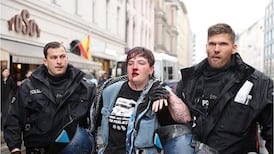More than once in his campaign for the White House, Joe Biden envisaged his presidency as the moment “hope and history rhyme”. Biden’s words, borrowed from Seamus Heaney’s play, The Cure at Troy, can easily be dismissed as rhetorical window-dressing, the poetry of the campaign trail that inevitably gives way to the pragmatic prose of governance.
However, Heaney’s words remain emblematic of President Biden’s challenge in this long season of American discontent: to act as healer-in-chief for a broken nation traumatized by upheaval, both domestic and global.
Biden’s vision for his presidency undertook to transcend the political realm and achieve something more unlikely – and profound
Addressed to the very “soul” of a suffering America, Biden’s vision for his presidency undertook to transcend the political realm and achieve something more unlikely – and profound.
Biden, like Heaney before him, understood the spiritual currency of hope.
READ MORE
For Heaney the poet and Biden the politician, Christianity is the dialect of their spirituality. As we approach the ninth anniversary of his death (which falls on August 30th), Heaney’s work offers a chance to reflect on what is unique about the Christian understanding of hope and what, if anything, it might say for the future of Joe Biden’s presidency.
The societal landscape to which Heaney raised his great paean of hope in 1990 was plotted deep with division and suffering. Delivered through an adaptation of Sophocles’ ancient Greek tragedy, Philoctetes, and addressed delicately to a divided Ireland emerging from the wounds of the Troubles, his The Cure at Troy is an act of supreme ventriloquism.
Over the years, the words of his opening “hope chorus” have become literary shorthand for a societal vision of hope that, in Heaney’s words, chooses “the civic, sober path of adjustment... over the intoxication of defiance”. Heaney’s adapted economy of hope in The Cure at Troy is geared toward the “the humdrum and caritas of renewal”, as the poet later put it. Even in the minutiae of translation, Heaney’s project is visible.
He has Philoctetes appeal for “pity for those less fortunate than yourself” – a version of social justice that is more Samaritan than Sophoclean, and one that does not appear in the Greek of Philoctetes.
Indeed, with the very final words of his work, Heaney leaves ringing in his audience’s ears the fragile suggestion that love of neighbour – that most Christian of concepts – is the path forward toward the vision of hope he has conjured in his work: “I leave/Half-ready to believe/That a crippled trust might walk/And the half-true rhyme is love.”
Nitty-gritty
Heaney’s vision of hope addresses itself to the nitty-gritty of daily human life, with its anticipating, its suffering, its longing for something better. In the Christian tradition, this is the same fragility toward which prayer addresses itself.
St Thomas Aquinas describes prayer as “the interpretation of hope” – humanity’s attempt to articulate the great uncertainty of its existence and the content of its desires. It is in this sense that Heaney’s great hope chorus in The Cure at Troy can be understood as a sort of poetic prayer.
Suggestions over the years that Heaney simply adds a Christian God to the ancient text are overblown.
The Christian idiom of Heaney’s work reminds us again that just as suffering touches every human heart, so too must hope if it is to be authenti
Something more instinctive is at play in Heaney’s deft adaptation across time. Christianity is simply the idiom of prayer for a poet whose life, by his own admission, had been “totally shaped” by his upbringing in the Christian faith.
The Christian idiom of Heaney’s work reminds us again that just as suffering touches every human heart, so too must hope if it is to be authentic. True hope subsists in the face of, indeed in the very teeth of the worst of human suffering. In this, it is distinguishable from what Terry Eagleton calls the “banality of optimism”.
Christian hope resides not, as for Sophocles’s Greek audience, in the interventions of a detached deus ex machina who offers an unlikely “fix” for our sufferings, but rather in the consolation of the deus non incompassibilis – a god who suffers with us (in the words of St Bernard of Clairvaux).
By experiencing and then overcoming its very worst excesses, Jesus gave meaning to our human suffering. He gave humanity his consolation, the promise to be literally “with us in our aloneness”. Even as upheaval, at home and abroad, threatens every side of America’s partisan society, the one quality that continues to distinguish Joe Biden as a leader seems to be his capacity for compassion (he claims to keep a running tally of America’s pandemic dead in his breast pocket).
Where Heaney the poet was studiously God-shy, the politician he inspired is not. Indeed, Christian prayer is still the idiom of hope that resonates with millions of Americans today.
If the President wishes to make good on his mission as healer-in-chief and govern in the spiritual idiom of his favourite Irish poet, the Christian tradition of hope would suggest that before all else, Biden must be a leader who suffers with his people.
Paul Corcoran is a doctorate researcher at TCD’s Loyola Institute specialising in the relationship between theology and poetry.












